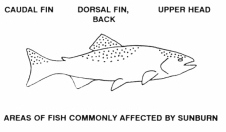Sunburn In Fish
Richard D. MocciaOAC Publication 1891
July 1991, Agdex 485/663
Intense exposure to the summer sun is a well known cause of skin burn in humans and animals. It might be surprising to know that fish also suffer from severe sunburn effects, to the point of causing death. Although water generally provides a very good barrier against most wavelengths of ultra-violet light - the sunburn culprit - it is known that middle and long U-V wavelengths can penetrate water for a few centimetres, particularly in water of high clarity. Water with even moderate turbidity from suspended solids, or discolouration from dissolved organic substances, usually provides an excellent barrier against all U-V wavelengths, and sunburn will not be a problem. However, if you are using a high clarity water source, like most groundwaters are, and have an outdoor facility, your fish may be in a particularly high risk category.
Sunburn usually occurs after extended periods of clear skies and intense sunlight in the summer-time, when solar radiation is at a more direct angle to the surface of the earth. Most salmonids (ie. trout, salmon and charr) have very little protective pigment in their skin, and are therefore overly sensitive to the effects of the sun. Excessive overcrowding, and some gill diseases, aggravate the problem by forcing fish to swim at or near the water's surface, often with the tops of their head and backs out of the water. In ultra-clear water, the fish can develop sunburn even if they are completely submerged, but are forced to within those top few centimetres of water where the U-V can still penetrate. Certain fish species seem to prefer swimming near the surface - like the Arctic Charr - and are prone to excessive sun exposure. Fish farms at high altitudes are more threatened due to the thinner atmosphere and lower filtering effect on the sun's rays, however this is not much of a concern in Ontario where the altitude of most farms is generally below 750 metres.
Fish develop skin sores in the areas exposed most directly to the sun, namely the top of the head, dorsal fin and upper back, and the top of the caudal fin. The affected skin first appears to turn a whitish colour and eventually becomes patchy, thickened and creamy coloured. Fins become frayed with a rough, ragged margin, and as the sores develop, the skin flakes off leaving a whitish or pink coloured ulcer exposing the underlying cartilage or muscle.
 In really severe
cases, the open sores can be so large that the fish loses
it's ability to osmoregulate properly and severe blood
chemistry imbalances and fatal kidney damage occurs.
Secondary bacterial and fungal infections often develop, and
sometimes mask the real sunburn lesion which initiated the
problem. These infections can be more devastating than the
sunburn effects if the problem is not diagnosed early and
the fish cared for properly. Unless the burns are very
severe, the fish usually feed well and appear otherwise
normal and active. This normally active behaviour is a good
sign that other more severe problems are not the cause of
the sores.
In really severe
cases, the open sores can be so large that the fish loses
it's ability to osmoregulate properly and severe blood
chemistry imbalances and fatal kidney damage occurs.
Secondary bacterial and fungal infections often develop, and
sometimes mask the real sunburn lesion which initiated the
problem. These infections can be more devastating than the
sunburn effects if the problem is not diagnosed early and
the fish cared for properly. Unless the burns are very
severe, the fish usually feed well and appear otherwise
normal and active. This normally active behaviour is a good
sign that other more severe problems are not the cause of
the sores.Mortality rates are usually low except in atypical cases, but surviving fish may become unmarketable due to their appearance, and ugly scar tissue can persist even after the sores heal. A mild case will heal completely in a few weeks, so it is important to respond to the problem when it first appears.
Certain chemical agents, such as phenothiazine (an insecticide and parasiticide) and sometimes even antibiotics or other therapeutic agents can cause photosensitization and exaggerate the effects of the sun. Thus, sun toxicity can occur where it otherwise wouldn't, if fish are accidentally or deliberately exposed to these sensitizing chemicals. If you are adding any special substances to the fishes' feed or water, it would be wise to inquire about the possible photosensitizing properties of those chemicals. Feed stored for excessively long periods may also contribute to sun sensitivity, since reductions in vitamin C in old feed can impair skin repair and slow healing rates which will aggravate otherwise minor sunburn sores. Niacin-deficient experimental diets have also been shown to contribute to sunburn in chinook salmon.
If you detect sunburn problems in your fish, try to provide shading, either by covering the tank with wood, styrofoam, shade cloth or other light shielding material. Reducing overcrowding or deepening the water also helps. Consider as well, the possibility of contamination of the feed or water with photosensitizing agents. And don't forget to call a fish health specialist or diagnostic laboratory such as the Fish Pathology Laboratory, University of Guelph, ph. 519-824-4120 ext.4640 to confirm your suspicions.
Halver, J.E. Fish Nutrition. 2nd Ed. 1987, Academic Press. pp. 417-418.